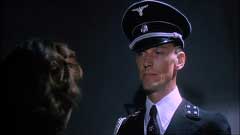 DEPORTED
WOMEN OF THE SS SPECIAL SECTION (1976)
DEPORTED
WOMEN OF THE SS SPECIAL SECTION (1976)Director: Rino Di Silvestro
Intervision Picture Corp./Severin Films
 DEPORTED
WOMEN OF THE SS SPECIAL SECTION (1976)
DEPORTED
WOMEN OF THE SS SPECIAL SECTION (1976)In the last days of World War II, the DEPORTED WOMEN OF THE SS SPECIAL SECTION wage a not so great escape in this loopy entry from WEREWOLF WOMAN's Rino Di Silvestro.

A group deported women arrive at a gothic castle functioning as a transitional camp where they will either be shipped off to be field whores or kept for the camp's medical experimentation unit. Among them is German aristocrat Tania Nobel (Lina Polito, LOVE AND ANARCHY) who spurned the camp's commander Herr Erner (John Steiner, TENEBRAE) five years before in favor of a resistance soldier. Injured in an escape attempt, Tania is punished with solitary confinement during which Erner attempts to win her over with displays of opulence and demonstrations of the control he wields over her fellow prisoners and the Kapos (fellow prisoners promoted to trustees of the blocks with all the corruption that entails), but she remains cold to him (but his valet Doberman [Guido Leontini, BLAZING FLOWERS] is always willing to give him a hand, so to speak). Meanwhile on the block, the Kapos – butch Trudy (Paola D'Egidio, MANDINGA), stunning Inge (Ofelia Meyer, Fulci's CONTRABAND), and stern Helga (Erna Schurer, SCREAM OF THE DEMON LOVER) under the strict command of Fraulein Greta (Solvi Stubing, STRIP NUDE FOR YOUR KILLER) – ferret out escape plots and punishable fraternizations through spying and torture. Having refused food and become an invalid, Tania is nursed back to health by sympathetic Dr. Schubert (Rik Battaglia, NIGHTMARE CASTLE) who tells her how she can escape the castle. She passes the word on to her fellow inmates and they stage a bloody escape while Tania hangs back to deal with Erner herself.
 By
no means a masterpiece of the subgenre or even Italian exploitation in general,
DEPORTED WOMEN OF THE SS SPECIAL SECTION makes for comparatively guilt-free
sleazy entertainment following the grim GESTAPO'S LAST ORGY – released
on disc concurrently by Intervision – with which it shares some plot similarities.
As mentioned by Nazisploitation expert Marcus Stiglegger in one of the disc's
featurettes, the film feels more like an Italian gothic horror film (as cited
by genre expert Marcus Stiglegger in one of the disc's featurettes) than a Nazisploitation
film, due largely to its castle setting, the production design of Nello Giorgetti
(PHENOMENA) in which Nazi red and black flags have the look of baroque drapery
and tapestry dotting the stone walls of long corridors, and Steiner's amusingly
over-the-top villain driven mad by Tania's mother's "breach of trust"
and the obsessive thought of Tania spreading her legs for a partisan soldier
(lead oddly Polito manages to avoid any actual nudity). The exploitation angle
thankfully favors sex (mostly lesbian, but also a forbidden affair between a
prisoner and a petty officer) over the offscreen medical experiments and a rather
half-hearted dungeon scene (in fact, one of the film's weaknesses may be that
Steiner's sadist is seen mainly involved administratively with the running of
the camp while the fates of the girls are decided by Stubing's fraulein and
the Kapos are responsible for the onscreen brutality). Sara Sperati (SALON KITTY),
Stefania D'Amario (Fulci's ZOMBIE), Felicita Fanny (RIOT IN A WOMEN'S PRISON),
and Maria Renata Franco (WEREWOLF WOMAN) are among the deportees. I haven't
seen Di Silvestro's earlier WOMEN OF CELL BLOCK 7, but DEPORTED WOMEN OF THE
SS SPECIAL SECTION is nowhere near as odd as his WEREWOLF WOMAN or as grim as
his CRISTIANE F.-ripoff HANNA D. – THE GIRL FROM VONDEL PARK, but Steiner's
caricature keeps it from being as dull as a more straightforward entry or one
of the more ludicrous Eurocine cash-ins. The film is lensed in cold hues by
Sergio D'Offizi (DON'T TORTURE THE DUCKLING) punctuated by stark blacks and
the bold reds of bloodshed and flags. The score is attributed to Stelvio Cipriani,
and I'm not sure how much of it is original since one of the prominent cues
is the "Evelyn Theme" from Mario Bava's BAY OF BLOOD.
By
no means a masterpiece of the subgenre or even Italian exploitation in general,
DEPORTED WOMEN OF THE SS SPECIAL SECTION makes for comparatively guilt-free
sleazy entertainment following the grim GESTAPO'S LAST ORGY – released
on disc concurrently by Intervision – with which it shares some plot similarities.
As mentioned by Nazisploitation expert Marcus Stiglegger in one of the disc's
featurettes, the film feels more like an Italian gothic horror film (as cited
by genre expert Marcus Stiglegger in one of the disc's featurettes) than a Nazisploitation
film, due largely to its castle setting, the production design of Nello Giorgetti
(PHENOMENA) in which Nazi red and black flags have the look of baroque drapery
and tapestry dotting the stone walls of long corridors, and Steiner's amusingly
over-the-top villain driven mad by Tania's mother's "breach of trust"
and the obsessive thought of Tania spreading her legs for a partisan soldier
(lead oddly Polito manages to avoid any actual nudity). The exploitation angle
thankfully favors sex (mostly lesbian, but also a forbidden affair between a
prisoner and a petty officer) over the offscreen medical experiments and a rather
half-hearted dungeon scene (in fact, one of the film's weaknesses may be that
Steiner's sadist is seen mainly involved administratively with the running of
the camp while the fates of the girls are decided by Stubing's fraulein and
the Kapos are responsible for the onscreen brutality). Sara Sperati (SALON KITTY),
Stefania D'Amario (Fulci's ZOMBIE), Felicita Fanny (RIOT IN A WOMEN'S PRISON),
and Maria Renata Franco (WEREWOLF WOMAN) are among the deportees. I haven't
seen Di Silvestro's earlier WOMEN OF CELL BLOCK 7, but DEPORTED WOMEN OF THE
SS SPECIAL SECTION is nowhere near as odd as his WEREWOLF WOMAN or as grim as
his CRISTIANE F.-ripoff HANNA D. – THE GIRL FROM VONDEL PARK, but Steiner's
caricature keeps it from being as dull as a more straightforward entry or one
of the more ludicrous Eurocine cash-ins. The film is lensed in cold hues by
Sergio D'Offizi (DON'T TORTURE THE DUCKLING) punctuated by stark blacks and
the bold reds of bloodshed and flags. The score is attributed to Stelvio Cipriani,
and I'm not sure how much of it is original since one of the prominent cues
is the "Evelyn Theme" from Mario Bava's BAY OF BLOOD.

Previously released on VHS by Video City Productions with two different covers as SS SPECIAL SECTION WOMEN and then on DVD by BCI (in a double feature with ESCAPE FROM WOMEN'S PRISON/LE EVASE) and more recently a Full Moon as part of their "Grindhouse Collection" (both in reportedly poor quality), DEPORTED WOMEN OF THE SS SPECIAL SECTION gets an anamorphic widescreen (1.78:1) transfer here that starts off rough with opening credits sourced from videotape (with tracking noise over the title card) but it switches over to newer transfer that is grainy as hell but surely an improvement over the earlier editions. Unlike the opening credits, the English language closing credits do not appear to be video-sourced. The English-dubbed Dolby Digital 2.0 mono is only in fair condition.
 Extras
include an interview with the director filmed some time before his 2009 death
called "Camp Rico" (29:28) in which he describes his privileged family
background, his interest in underwater photography at a young age, and his brushes
with famous Italian filmmakers that lead to his interest in cinema (first as
an actor, then as a ghostwriter). He discusses uncredited collaborations with
Lucio Fulci and Enzo Castellari before his directorial debut WOMEN OF CELL BLOCK
7. He speaks of DEPORTED WOMEN OF THE SS as if it was an innovative film, and
is especially proud of his obsessive research and the necessity of adapting
the Hitlerian mindset as a director. Silvestro identifies the castle location
as Bracciano's Castle, the popular name for Castello Orsini-Odescalchi which
also appeared in THE INGLORIOUS BASTARDS, CASTLE OF THE LIVING DEAD, Visconti's
THE LEOPARD, and the Empire Pictures production SPELLCASTER among others. He
speaks warmly of Stubing and Polito, and speaks of Steiner as if he made him
a star (making no mention of SALON KITTY and saying Steiner begged him for the
role). In "What Does John Steiner Think?" (9:18), Steiner passes the
film off as a joke that he did for money, which is more believable since he
has said in the past that he took acting jobs for the money and for travel.
Now a Los Angeles real estate agent, he was unaware that he or his films had
a following until Sage Stallone contacted him looking for a house. He recalls
wondering what Polito was doing in the film since Silvestro had to work hard
to not show her nude in nude scenes, and also recalls the director's suggestions
for props for the infamous cork-and-razor scene at the end. Although shorter,
it's a more entertaining and probably more accurate account of the film.
Extras
include an interview with the director filmed some time before his 2009 death
called "Camp Rico" (29:28) in which he describes his privileged family
background, his interest in underwater photography at a young age, and his brushes
with famous Italian filmmakers that lead to his interest in cinema (first as
an actor, then as a ghostwriter). He discusses uncredited collaborations with
Lucio Fulci and Enzo Castellari before his directorial debut WOMEN OF CELL BLOCK
7. He speaks of DEPORTED WOMEN OF THE SS as if it was an innovative film, and
is especially proud of his obsessive research and the necessity of adapting
the Hitlerian mindset as a director. Silvestro identifies the castle location
as Bracciano's Castle, the popular name for Castello Orsini-Odescalchi which
also appeared in THE INGLORIOUS BASTARDS, CASTLE OF THE LIVING DEAD, Visconti's
THE LEOPARD, and the Empire Pictures production SPELLCASTER among others. He
speaks warmly of Stubing and Polito, and speaks of Steiner as if he made him
a star (making no mention of SALON KITTY and saying Steiner begged him for the
role). In "What Does John Steiner Think?" (9:18), Steiner passes the
film off as a joke that he did for money, which is more believable since he
has said in the past that he took acting jobs for the money and for travel.
Now a Los Angeles real estate agent, he was unaware that he or his films had
a following until Sage Stallone contacted him looking for a house. He recalls
wondering what Polito was doing in the film since Silvestro had to work hard
to not show her nude in nude scenes, and also recalls the director's suggestions
for props for the infamous cork-and-razor scene at the end. Although shorter,
it's a more entertaining and probably more accurate account of the film.
 The
disc also carries over "A Brief History of 'Sadiconazista'" (36:28)
from the concurrent release of GESTAPO'S LAST ORGY in which German film studies
professor Dr. Marcus Stiglegger – who penned the introduction for NAZISPLOITATION!:
THE NAZI IMAGE IN LOW-BROW CINEMA AND CULTURE – discusses the origins
of Nazisploitation cinema and the very Italian association of sadomasochism
and national socialism. He starts off by informing us that the subgenre's origins
were not in films like THE NIGHT PORTER, SALON KITTY, and Visconti's THE DAMNED
but in British and Russian anti-Nazi wartime campaigns which featured imagery
depicting nude or scantily-clad women being victimized. He also discusses some
earlier films that sexualized Nazism, as well as other art film antecedents
like Gilo Pontecorvo's KAPO and Wanda Jakubowska's THE LAST STAGE, as well as
novels like SALON KITTY and HOUSE OF DOLLS (which inaccurately suggested that
the camp brothels were for the soldiers when they were actually for rewarding
the prisoners who collaborated). He points out that the Visconti, Cavani, and
Brass films (the latter establishing the bordello motif) may have been directly
responsible for the subgenre, but that Lee Frost' s roughie LOVE CAMP 7 (1969)
was closer in spirit. He traces the inspiration for the Canadian ILSA, SHE WOLF
OF THE SS to rumors about concentration camp commander's wife Ilse Koche as
well as Israeli Lager pulp fiction. He also informs us that Nazisploitation
films were not well-received in Italy at the time and did not play in Germany
at all. Although most of them are not particularly good, they attained a cult
status in Europe due to their unavailability as well as the banning of some
of the titles during the Video Nasty debacle. He cites GESTAPO'S LAST ORGY and
DEPORTED WOMEN OF THE SS SPECIAL SECTION as two of the better entries, citing
the less racial rather than political relationship between captor and captive
compared to THE NIGHT PORTER (Lise is Jewish while Rampling's character was
the daughter of a socialist) in the former and the over-the-top gothic horror
elements of the latter. (Eric
Cotenas)
The
disc also carries over "A Brief History of 'Sadiconazista'" (36:28)
from the concurrent release of GESTAPO'S LAST ORGY in which German film studies
professor Dr. Marcus Stiglegger – who penned the introduction for NAZISPLOITATION!:
THE NAZI IMAGE IN LOW-BROW CINEMA AND CULTURE – discusses the origins
of Nazisploitation cinema and the very Italian association of sadomasochism
and national socialism. He starts off by informing us that the subgenre's origins
were not in films like THE NIGHT PORTER, SALON KITTY, and Visconti's THE DAMNED
but in British and Russian anti-Nazi wartime campaigns which featured imagery
depicting nude or scantily-clad women being victimized. He also discusses some
earlier films that sexualized Nazism, as well as other art film antecedents
like Gilo Pontecorvo's KAPO and Wanda Jakubowska's THE LAST STAGE, as well as
novels like SALON KITTY and HOUSE OF DOLLS (which inaccurately suggested that
the camp brothels were for the soldiers when they were actually for rewarding
the prisoners who collaborated). He points out that the Visconti, Cavani, and
Brass films (the latter establishing the bordello motif) may have been directly
responsible for the subgenre, but that Lee Frost' s roughie LOVE CAMP 7 (1969)
was closer in spirit. He traces the inspiration for the Canadian ILSA, SHE WOLF
OF THE SS to rumors about concentration camp commander's wife Ilse Koche as
well as Israeli Lager pulp fiction. He also informs us that Nazisploitation
films were not well-received in Italy at the time and did not play in Germany
at all. Although most of them are not particularly good, they attained a cult
status in Europe due to their unavailability as well as the banning of some
of the titles during the Video Nasty debacle. He cites GESTAPO'S LAST ORGY and
DEPORTED WOMEN OF THE SS SPECIAL SECTION as two of the better entries, citing
the less racial rather than political relationship between captor and captive
compared to THE NIGHT PORTER (Lise is Jewish while Rampling's character was
the daughter of a socialist) in the former and the over-the-top gothic horror
elements of the latter. (Eric
Cotenas)